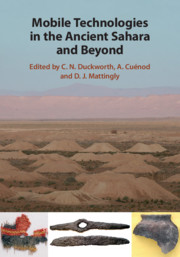Book contents
- Mobile Technologies in the Ancient Sahara and Beyond
- The Trans-Saharan Archaeology Series
- Mobile Technologies in the Ancient Sahara and Beyond
- Copyright page
- Contents
- Figures
- Tables
- Contributors
- Preface
- Part I Introduction
- Part II Technological Mobility and Transfers
- Part III Metallurgy
- 7 Metalworking in Pre-Islamic North Africa
- 8 Is the Archaeometallurgical Record a Valuable Tool when Considering Meroe within a Trans-Saharan Landscape?
- 9 What Is the Meaning of the Extreme Variability of Ancient Ironworking in West Africa?
- Part IV Glass Technology
- Part V Handmade Pottery
- Part VI Conclusion
- Index
- References
9 - What Is the Meaning of the Extreme Variability of Ancient Ironworking in West Africa?
A Comparison between Four Case Studies
from Part III - Metallurgy
Published online by Cambridge University Press: 18 September 2020
- Mobile Technologies in the Ancient Sahara and Beyond
- The Trans-Saharan Archaeology Series
- Mobile Technologies in the Ancient Sahara and Beyond
- Copyright page
- Contents
- Figures
- Tables
- Contributors
- Preface
- Part I Introduction
- Part II Technological Mobility and Transfers
- Part III Metallurgy
- 7 Metalworking in Pre-Islamic North Africa
- 8 Is the Archaeometallurgical Record a Valuable Tool when Considering Meroe within a Trans-Saharan Landscape?
- 9 What Is the Meaning of the Extreme Variability of Ancient Ironworking in West Africa?
- Part IV Glass Technology
- Part V Handmade Pottery
- Part VI Conclusion
- Index
- References
Summary
Iron production has played a part in the history of Africa for more than 2,500 years. The study of this specific human activity has demonstrated its exceptional significance, its historical continuity and an astonishing variability of practice. In Sub-Saharan Africa, metallurgists developed different ways to produce the same material: iron. They multiplied the technical choices to a degree unequalled on other continents. But what is the significance of such extreme diversity? In this chapter, four case studies representing different situations are detailed: in Dendi Country/Benin, where the question of the nature of the raw materials is considered; in Dogon Country/Mali, seven contemporaneous smelting traditions in a limited geographical area; at the Korsimoro site/Burkina Faso, five successive smelting traditions in the same place; and in the Bassar region/Togo, the impact of ancient and intensive iron production on the environment and on the technology. Based on these examples the chapter discusses the interpretation of diversity in terms of the history of technology and population dynamics.
- Type
- Chapter
- Information
- Mobile Technologies in the Ancient Sahara and Beyond , pp. 290 - 314Publisher: Cambridge University PressPrint publication year: 2020
References
- 1
- Cited by

